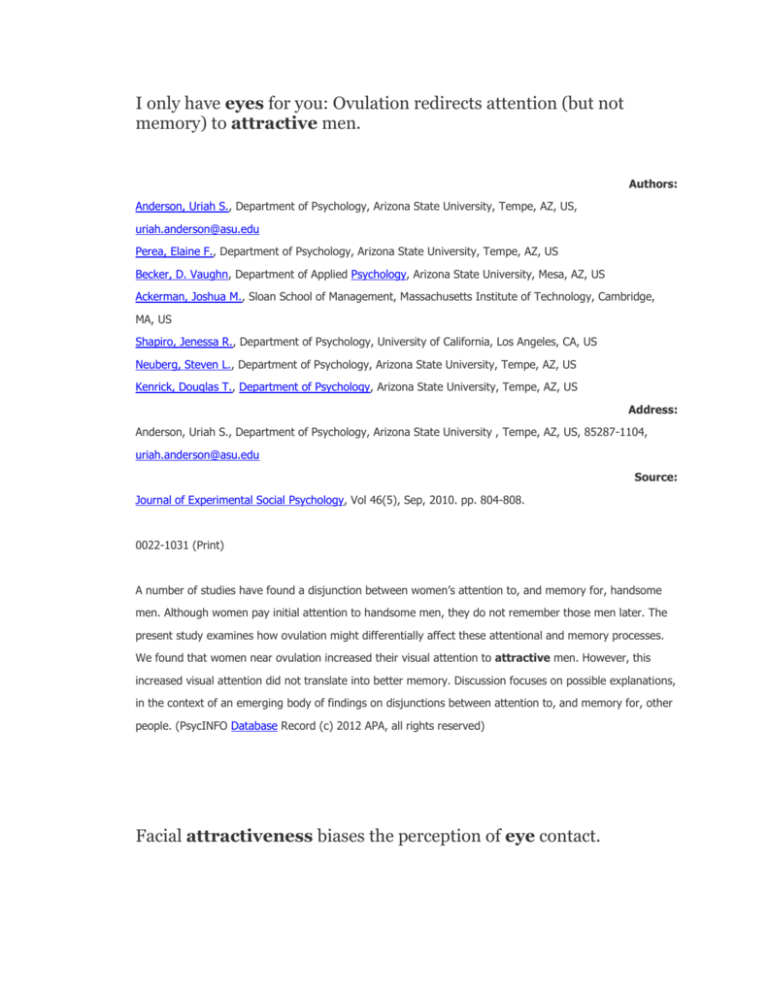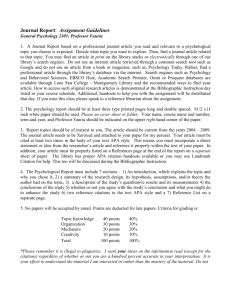
I only have eyes for you: Ovulation redirects attention (but not
memory) to attractive men.
Authors:
Anderson, Uriah S., Department of Psychology, Arizona State University, Tempe, AZ, US,
uriah.anderson@asu.edu
Perea, Elaine F., Department of Psychology, Arizona State University, Tempe, AZ, US
Becker, D. Vaughn, Department of Applied Psychology, Arizona State University, Mesa, AZ, US
Ackerman, Joshua M., Sloan School of Management, Massachusetts Institute of Technology, Cambridge,
MA, US
Shapiro, Jenessa R., Department of Psychology, University of California, Los Angeles, CA, US
Neuberg, Steven L., Department of Psychology, Arizona State University, Tempe, AZ, US
Kenrick, Douglas T., Department of Psychology, Arizona State University, Tempe, AZ, US
Address:
Anderson, Uriah S., Department of Psychology, Arizona State University , Tempe, AZ, US, 85287-1104,
uriah.anderson@asu.edu
Source:
Journal of Experimental Social Psychology, Vol 46(5), Sep, 2010. pp. 804-808.
:
0022-1031 (Print)
A number of studies have found a disjunction between women’s attention to, and memory for, handsome
men. Although women pay initial attention to handsome men, they do not remember those men later. The
present study examines how ovulation might differentially affect these attentional and memory processes.
We found that women near ovulation increased their visual attention to attractive men. However, this
increased visual attention did not translate into better memory. Discussion focuses on possible explanations,
in the context of an emerging body of findings on disjunctions between attention to, and memory for, other
people. (PsycINFO Database Record (c) 2012 APA, all rights reserved)
Facial attractiveness biases the perception of eye contact.
Authors:
Kloth, Nadine, Department of Psychology, Friedrich Schiller University of Jena, Jena, Germany,
nadine.kloth@uwa.edu.au
Altmann, Carolin S., Department of Psychology, Friedrich Schiller University of Jena, Jena, Germany
Schweinberger, Stefan R., Department of Psychology, Friedrich Schiller University of Jena, Jena, Germany
Address:
Kloth, Nadine, School of Psychology, University of Western Australia (M304), 35 Stirling Highway, Crawley,
WAU, Australia, 6009, nadine.kloth@uwa.edu.au
Source:
The Quarterly Journal of Experimental Psychology, Vol 64(10), Oct, 2011. pp. 1906-1918.
Page Count:
:
The Quarterly Journal of Experimental Psychology A: Human Experimental Psychology
Attractive faces are appealing: We like to look at them, and we like to be looked at by them. We
presented attractive and unattractive smiling and neutral faces containing identical eye regions with
different gaze directions. Participants judged whether or not a face looked directly at them. Overall,
attractive faces increased participants' tendency to perceive eye contact, consistent with a self-referential
positivity bias. However, attractiveness effects were modulated by facial expression and gender: For
female faces, observers more likely perceived eye contact in attractive than unattractive faces,
independent of expression. For male faces, attractiveness effects were limited to neutral expressions and
were absent in smiling faces. A signal detection analysis elucidated a systematic pattern in which (a) smiling
faces, but not highly attractive faces, reduced sensitivity in gaze perception overall, and (b)
attractiveness had a more consistent impact on bias than sensitivity measures. We conclude that
combined influences of attractiveness, expression, and gender determine the formation of an overall
impression when deciding which individual's interest in oneself may be beneficial and should be
reciprocated. (PsycINFO Database Record (c) 2012 APA, all rights reserved)
Your eyes reveal the secrets of your interests.
Brandt, H. F.
Proceedings of the Iowa Academy of Science, 51, 1944. pp. 361-366.
6
English
SEX, DIFFERENCES, INTERESTS, EYE-CAMERA EXPERIMENT, INTELLIGENCE TEST,
INTEREST, SEX DIFFERENCES, EYE-CAMERA EXPERIMENT, INDUSTRIAL AND
PERSONNEL PROBLEMS
A bidimensional eye-camera was used to record the relative time spent in looking at pictures.
Fifty subjects were tested on a two-page spread of two columns each, one page containing
pictures of men, the other of women. It was found that significantly more time was spent looking
at pictures on the inside positions of the lay-out than on the outside positions. Preference was
shown for the outer left-hand column over the outer right-hand column. Men spent more time
looking at pictures of women than at pictures of men, while women spent approximately an
equal amount of time on the two sexes. Seventy-five men and 75 women observed a page each of
men's and women's shoes. Men spent significantly more time on articles related to their needs.
Women spent relatively more time on masculine articles than men did on articles generally used
by women. (PsycINFO Database Record (c) 2012 APA, all rights reserved)
No terms assigned
Industrial & Organizational Psychology (3600)
In the eyes of the beholder: Students' and teachers' judgments of students motivation.
Givvin, Karen B., U California, Coririnne A Seeds U Elementary School, Los Angeles, CA, US
Stipek, Deborah J.
Salmon, Julie M.
MacGyvers, Valanne L.
Teaching and Teacher Education, Vol 17(3), Apr, 2001. pp. 321-331.
11
Netherlands: Elsevier Science.
0742-051X (Print)
English
ratings of students' motivation in mathematics throughout school year, 4th–6th grade students vs
teachers
Examined the nature and accuracy of teachers' judgments about students' motivation related to
mathematics. Seventeen 4th–6th-grade teachers and 100 of their students participated in this
study. Teachers were asked to rate six target students' motivation four times during the school
year. At each of these times, students also rated their own motivation. Teachers' ratings were
more stable over time and across mathematics topics and were less differentiated across
motivation dimensions than were students' ratings. The findings suggest that teachers need to pay
careful attention to evidence related to children's motivation that might contradict their
perceptions and therefore support more effective interventions. (PsycINFO Database Record (c)
2012 APA, all rights reserved)
*Elementary Education; *Mathematics Education; *Motivation; *Student Characteristics;
*Teacher Attitudes; Elementary School Students; Elementary School Teachers
Looking and acting: Vision and eye movements in natural behaviour.
Land, Michael F., Department of Biology and Environmental Science, University of Sussex,
United Kingdom
Tatler, Benjamin W., School of Psychology, University of Dundee, United Kingdom
New York, NY, US: Oxford University Press, 2009. xi, 269 pp.
978-0-19-857094-3 (Paperback)
English
eye movement, visually guided behavior
(from the cover) The cooperative action of different regions of our brains gives us an amazing
capacity to perform activities as diverse as playing the piano and hitting a tennis ball. Somehow,
without conscious effort, our eyes find the information we need to operate successfully in the
world around us. The development of head-mounted eye trackers over recent years has made it
possible to record where we look during different active tasks, and so work out what information
our eyes supply to the brain systems that control our limbs. We are now in a position to explore
the strategies that the eye movement system uses in the initiation and guidance of action.
Looking and Acting examines a wide range of visually guided behaviour, from sedentary tasks
like reading and drawing, to dynamic activities such as driving and playing cricket. A central
theme is that the eye movement system has its own knowledge about where to find the most
appropriate information for guiding action - information not usually available to conscious
scrutiny. Thus each type of action has its own specific repertoire of linked eye movements,
acquired in parallel with the motor skills themselves. Starting with a brief background to eye
movement studies, the book then reviews a range of observations and analyses of different
activities. It ends with discussions of the nature of visual representation, the neurophysiology of
the systems involved, and the roles of attention and learning. Opening a field in eye movement
research, this fascinating book will be of great interest to all vision scientists (psychologists,
physiologists, ophthalmologists) whether at professional, graduate, or advanced undergraduate
levels. It will also be of value to musicians, artists, sports scientists, and transport engineers, and
indeed anyone intrigued by the way we sample the visual world. (PsycINFO Database Record (c)
2012 APA, all rights reserved)
Title:
Authors:
Address:
Selective attention of patients with anorexia nervosa while looking at pictures of
their own body and the bodies of others: An exploratory study.
von Wietersheim, Jörn, Department of Psychosomatic Medicine and Psychotherapy,
Ulm University, Ulm, Germany, joern.vonwietersheim@uniklinik-ulm.de
Kunzl, Franziska, Department of Psychosomatic Medicine and Psychotherapy, Ulm
University, Ulm, Germany
Hoffmann, Holger, Department of Psychosomatic Medicine and Psychotherapy,
Ulm University, Ulm, Germany
Glaub, Julia, Department of Psychosomatic Medicine and Psychotherapy, Ulm
University, Ulm, Germany
Rottler, Edit, Department of Psychosomatic Medicine and Psychotherapy, Ulm
University, Ulm, Germany
Traue, Harald C., Department of Psychosomatic Medicine and Psychotherapy, Ulm
University, Ulm, Germany
von Wietersheim, Jörn, Department of Psychosomatic Medicine and Psychotherapy,
Ulm University Am Hochstrass 8, 89081, Ulm, Germany,
joern.vonwietersheim@uniklinik-ulm.de
Psychosomatic Medicine, Vol 74(1), Jan, 2012. pp. 107-113.
7
Source:
Page
Count:
Publisher: US: Lippincott Williams & Wilkins.
1534-7796 (Electronic)
ISSN:
0033-3174 (Print)
Language: English
Keywords: selective attention, anorexia nervosa, body pictures, body image
Abstract: Objective: Attention and assessment biases are part of body image disturbances
shown by patients with anorexia nervosa (AN). The aim of this article was to study
these biases by using eye movement analyses. Methods: As stimuli, the study used
24 standardized pictures showing young women and a standardized picture of the
respective study participant. With an eye movement tracer, we were able to
determine what body areas that the study participants look at. The study participants
were also asked to rate the attractiveness of the stimuli. Data from 35 patients with
AN and 32 healthy controls were included. Results: Patients with AN judge their
own body areas as being less attractive than the controls on a rating scale from 1 to 5
(e.g., breasts: mean [standard deviation] = 0.9 [1.0] versus 2.2 [0.8], p < .001). They
were also more critical in their assessment of the bodies of others (e.g.,
attractiveness of people with ideal weight: 2.1 [0.9] versus 2.8 [0.5], p < .001). They
spent less time looking at their own breasts (1.8 [0.9] versus 2.2 [1.0] seconds, p =
.09) but significantly more time at their thighs (1.1 [0.6] versus 0.8 [0.4] seconds, p
= .05). Conclusions: The results confirm the assumption of cognitive biases. The
differences, however, are often small and vary greatly. (PsycINFO Database Record
(c) 2012 APA, all rights reserved)
Subjects: *Anorexia Nervosa; *Body Image; *Selective Attention
Looking without seeing or seeing without looking? Eye movements in sustained inattentional
blindness.
Beanland, Vanessa, Department of Psychology, Australian National University, Canberra, ACT,
Australia, vanessa.beanland@anu.edu.au
Pammer, Kristen, Department of Psychology, Australian National University, Canberra, ACT,
Australia
Beanland, Vanessa, Department of Psychology, Australian National University , Canberra, ACT,
Australia, 0200, vanessa.beanland@anu.edu.au
Vision Research, Vol 50(10), May 12, 2010. pp. 977-988.
12
Netherlands: Elsevier Science.
0042-6989 (Print)
English
eye movements, inattentional blindness, stimulation
Inattentional blindness (IB) describes the failure to notice salient but unexpected stimuli when
attention is partially engaged by another task. Few studies have explicitly investigated the role of
eye movements in IB and the relative contributions of overt and covert attention. We recorded
eye movements in a series of IB experiments using dynamic stimuli. Results indicate that eye
movements do not predict IB; noticers and nonnoticers were equally likely to fixate on or near
the unexpected item, often for similar durations. Perceptual load also determines whether
observers will fixate the unexpected object. In a high perceptual load task, IB was high (81%)
and most participants did not allocate overt attention to the unexpected object. Under lower
perceptual load IB decreased to 54% and both noticers and nonnoticers fixated on the unexpected
object. (PsycINFO Database Record (c) 2012 APA, all rights reserved)
*Eye Movements; *Stimulation; *Visual Perception; *Visual Attention





